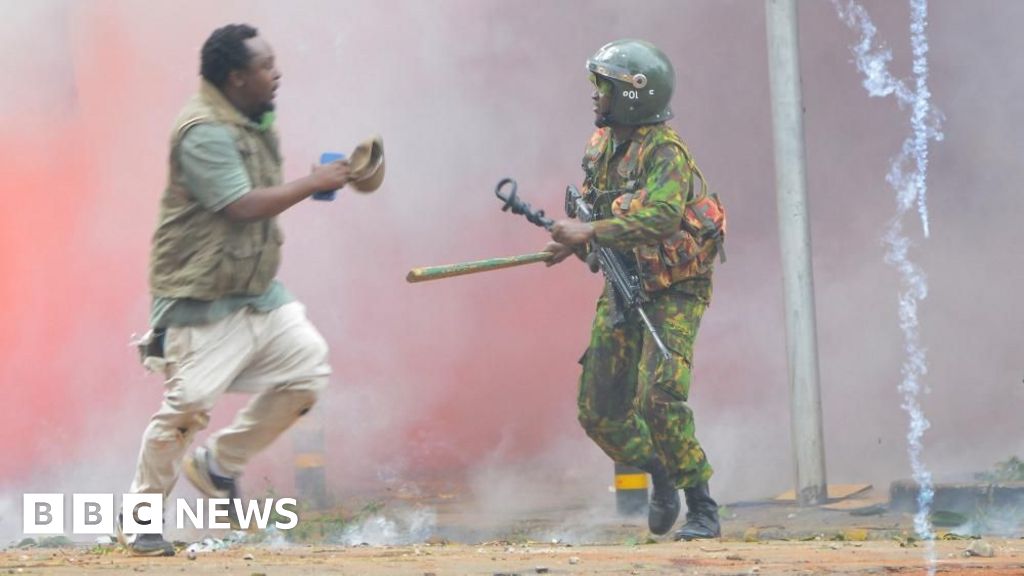At least eight people have been killed and 400 injured in nationwide protests in Kenya against President William Ruto's government, doctors and rights groups have said. Police clashed with protesters, who marched in their thousands - some chanting "Ruto must go" and waving branches as a symbol of peaceful opposition to his rule. The government banned live TV and radio coverage of the demonstrations, but its decree was overturned by the High Court in the capital, Nairobi. Ruto urged protesters not to threaten peace and stability, as crowds tried to reach his official residence but were pushed back by police. The president was speaking at a burial ceremony in the coastal county of Kilifi. "Protests should not be to destroy peace in Kenya. We do not have another country to go to when things go wrong. It is our responsibility to keep our country safe," he said. Ruto's absence from State House, his official residence, was notable as young protesters threatened to storm it. Police used barricades and razor wire to seal off major roads - especially those leading to State House and parliament. The protests were held exactly a year after demonstrators stormed parliament, setting part of the building ablaze. At least 60 people were killed in a wave of anti-government protests last year. The authorities have not yet given any casualty figures from Wednesday's protests, but the Kenya Medical Association, Law Society of Kenya and the Police Reforms Working Group said in a joint statement that at least eight protesters were killed. Of the 400 injured, 83 required "specialised treatment" and eight had suffered gunshot wounds. The injured included three police officers, the statement added. Amina Mude told the BBC she joined the protests "to fight for the future of my kids". "I feel like as a country we're not going in the right direction, especially in education and everything happening. "I feel like it's high time that the country and the leadership listens to us." Video footage showed plumes of white tear gas drifting between tall buildings, sending protesters scrambling for cover, coughing, and shielding their eyes. But they returned, chanting defiantly. In the heart of Nairobi, protesters marched pass shuttered shops and empty streets. The razor wire fencing around parliament stood as a stark reminder of last year's violent unrest. On Wednesday, the fence around parliament was lined with wreaths and handwritten notes from grieving families and defiant youths. A young woman draped in a Kenyan flag clutched a poster bearing the names of those killed a year ago by the security forces as they tried to end the protests. Go toBBCAfrica.comfor more news from the African continent. Follow us on Twitter@BBCAfrica, on Facebook atBBC Africaor on Instagram atbbcafrica
Eight killed as Kenya protesters battle police, medics say
TruthLens AI Suggested Headline:
"Protests in Kenya Result in Eight Deaths Amid Calls for Government Accountability"
TruthLens AI Summary
In Kenya, nationwide protests against President William Ruto's government have resulted in at least eight fatalities and around 400 injuries, according to reports from medical professionals and human rights organizations. The protests, which saw thousands of demonstrators chanting slogans such as 'Ruto must go' and carrying branches as symbols of peaceful dissent, were met with a heavy police presence. The government attempted to restrict media coverage of the events, but a High Court ruling in Nairobi overturned this ban. During the unrest, police clashed with protesters, especially as crowds attempted to approach the president's official residence. Ruto, who was attending a burial ceremony in Kilifi at the time, called for peaceful demonstrations, emphasizing that protests should not disrupt the nation's peace and stability. He stated, 'We do not have another country to go to when things go wrong. It is our responsibility to keep our country safe.'
The protests occurred on the anniversary of a violent episode from the previous year when demonstrators stormed parliament, leading to significant casualties. This year, the Kenya Medical Association, Law Society of Kenya, and Police Reforms Working Group reported that eight protesters were killed, with 83 of the injured requiring specialized medical treatment. Among the injured were three police officers. Eyewitness accounts and video footage captured the chaotic scenes as tear gas filled the air, causing protesters to flee and seek cover, yet they returned to march defiantly. In Nairobi, the atmosphere was tense, with barricades and razor wire erected around key locations, including parliament. Memorials with wreaths and messages from grieving families served as poignant reminders of the violence from the previous protests, underscoring the ongoing struggle for justice and accountability in Kenya's political landscape.
TruthLens AI Analysis
You need to be a member to generate the AI analysis for this article.
Log In to Generate AnalysisNot a member yet? Register for free.
